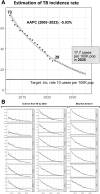Assessing the impact of the TB response in Taiwan - the journey towards ending TB
- PMID: 40365028
- PMCID: PMC12068451
- DOI: 10.5588/ijtldopen.25.0103
Assessing the impact of the TB response in Taiwan - the journey towards ending TB
Abstract
The incidence of TB in Taiwan declined by 62% from 2005 to 2023 (i.e., from 73/100,000 to 28/100,000). Here we review the past two decades of TB epidemiology, policy implementation, and outcomes, identifying gaps and solutions for domestic and global responses. An external review in 2024 assessed National TB Program progress towards the End TB goal, integrating feedback from an International Review Panel and a 2023 expert questionnaire. The findings informed Phase III (2026-2030) of the 'End TB by 2035 Project'. We present review materials, consensus recommendations, and follow-ups through 2024. In 2023, 64% of the TB cases were aged ≥ 65. TB incidence among those < 60 is projected to meet the End TB targets (<10/100,000) by 2035, while elimination (<1 per million) is expected among 0-14-year-olds. During 2005-2024, Taiwan universally adopted new diagnostic tools for drug-resistant TB, shorter regimens and user-friendly platforms for reporting and case management. Nationwide policy innovations included active case finding, and TB infection (TBI) treatment. Taiwan's consistent investment in TB reflects strong political commitment to End TB. Current challenges include aging, co-morbidities, high TB/TBI among foreign migrant workers and societal disparities, and we suggest that future efforts must leverage artificial intelligence, universal genotyping and greater inter-departmental collaboration.
Keywords: End TB strategies; TB elimination; policy implementation; tuberculosis.
© 2025 The Authors.
Figures





Similar articles
-
Tuberculosis.In: Holmes KK, Bertozzi S, Bloom BR, Jha P, editors. Major Infectious Diseases. 3rd edition. Washington (DC): The International Bank for Reconstruction and Development / The World Bank; 2017 Nov 3. Chapter 11. In: Holmes KK, Bertozzi S, Bloom BR, Jha P, editors. Major Infectious Diseases. 3rd edition. Washington (DC): The International Bank for Reconstruction and Development / The World Bank; 2017 Nov 3. Chapter 11. PMID: 30212088 Free Books & Documents. Review.
-
[Tuberculosis in Asia].Kekkaku. 2002 Oct;77(10):693-7. Kekkaku. 2002. PMID: 12440145 Japanese.
-
Paradigm shift in efforts to end TB by 2025.Indian J Tuberc. 2020 Dec;67(4S):S48-S60. doi: 10.1016/j.ijtb.2020.11.001. Epub 2020 Nov 10. Indian J Tuberc. 2020. PMID: 33308672 Review.
-
Advancing tuberculosis elimination in India: A qualitative review of current strategies and areas for improvement in tuberculosis preventive treatment.IJID Reg. 2024 Dec 21;14:100556. doi: 10.1016/j.ijregi.2024.100556. eCollection 2025 Mar. IJID Reg. 2024. PMID: 39866845 Free PMC article. Review.
-
The future of Cochrane Neonatal.Early Hum Dev. 2020 Nov;150:105191. doi: 10.1016/j.earlhumdev.2020.105191. Epub 2020 Sep 12. Early Hum Dev. 2020. PMID: 33036834
References
-
- Pratt RH, et al. . Tuberculosis in older adults in the United States, 1993-2008. Journal of the American Geriatrics Society 2011;59(5):851-857. - PubMed
-
- Lee CS, et al. . The incidence of tuberculosis recurrence: Impacts of treatment duration of and adherence to standard anti-tuberculous therapy. J Infect Public Health 2023;16(11):1778-1783. - PubMed
-
- World Health Organization . Innovative solutions for the elimination of tuberculosis among migrants and refugees. Report of the 7th edition of the World Innovation Summit for Health. Geneva, Switzerland: WHO, 2024.
LinkOut - more resources
Full Text Sources
Miscellaneous
